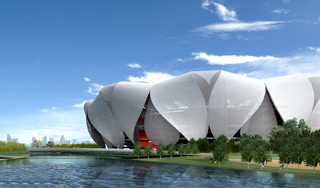
NBBJ
Specialty: Architecture, master planning, health care, interiors, retail, graphic design and signage, space planning, land use, facility planning, change management, construction administration, project and cost management
Management: Steve McConnell, managing partner; Scott Wyatt, managing partner; Jay Halleran, managing partner; Joanna Lohkamp, CFO/COO
Founded: 1943
Headquarters: Seattle
2010 revenues: $193.8 million
Projected 2011 revenues: $198 million
Employees: 700
Current projects: Bill & Melinda Gates Foundation campus, Seattle; Stanford University Li Ka Shing Center for Learning and Knowledge, Palo Alto, Calif.; Massachusetts General Hospital Lunder Building, Boston; Microsoft China R&D Center, Beijing; New Orleans VA Medical Center

Image courtesy of NBBJ An 80,000-seat stadium will serve as the centerpiece of a 99-acre sports and recreation development that NBBJ is designing for Hangzhou, China. It is scheduled to open in 2013.
|
NBBJ, with 700 employees and gross revenues of nearly $194 million in 2010, ranks among the world’s 150 largest design firms, according to Engineering News-Record.
With six offices in the U.S., four international offices and 17 design studios around the world, NBBJ leaves its mark in places far and wide.
China, with its bustling economy, has provided the firm with a slew of major projects in recent years, including a recently completed Microsoft research center in Beijing, a new master plan for the city of Karamay, and a sports-and-recreation development in Hangzhou.
International work has buoyed NBBJ through the recession, said Steve McConnell, a managing partner. Other project locales include countries such as the U.K., Ireland, Russia, Kuwait, South Korea and Kazakhstan.
The Karamay master plan in western China required “a massive amount of design,” McConnell said, drawing participation from staff from seven different offices. Having the ability to use personnel from other offices to assist where needed has proven helpful to the firm.
“A day doesn’t go by when we’re not doing videoconferencing,” he said.
More services
Revenues fell $8 million, or 4 percent, from 2009 to 2010, but NBBJ has responded to stormy market conditions by widening its range of services. The firm expects to see revenue gains in 2011.
“When you look at the shock of recession, one can reel or take a defensive posture, or redouble on value creation, driving forward to ensure high relevance,” McConnell said.
One area of focus has been pre- and post-design consulting services such as post-occupancy evaluations. Such offerings can help clients reduce their exposure to risk, he said.
The object of expanding services isn’t to do “all the work we can get our hands on,” McConnell said, but to be able to better address clients’ needs, staying focused on value creation and innovation while avoiding commoditized services.
Change management
Another effect of the recession has been to dampen domestic demand for new commercial buildings. NBBJ shifted its attention to federal stimulus projects, such as courthouses and other civic projects.
Its heath-care division has also kept busy with projects such as the Lunder Building at Massachusetts General Hospital in Boston and a $1.2 billion medical center for the U.S. Department of Veterans Affairs in New Orleans.
As governments budgets shrink, “there is a lot less ready investment in buildings and things like that,” McConnell said.
A growing service for NBBJ is change management, such as helping agencies reshuffle into smaller spaces while preserving their staff size.
“This kind of change presents an opportunity to address shrinking budgets while incorporating proven ideas that increase collaboration and communication,” he said.
Still, government at all levels in the U.S. has made strides in its thinking about energy efficiency and conservation, McConnell said.
“I hope to see the bar keep going up on that stuff.”